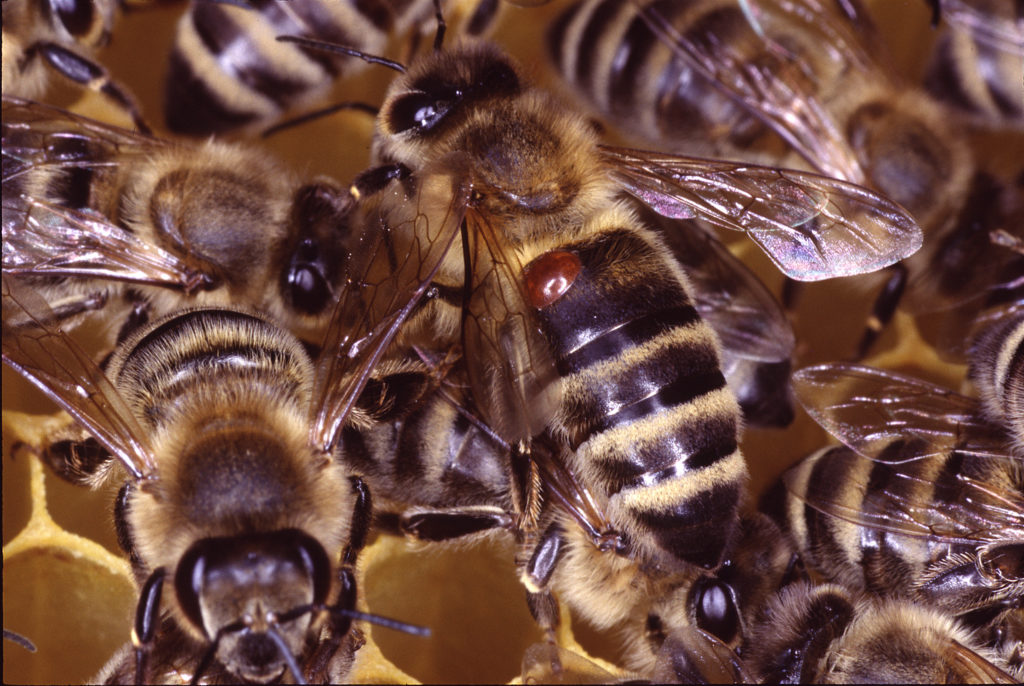Varroa Mites – What Every Beekeeper Should Know
Varroa mites are a plague among beekeepers, but they also have some drastic effects on bee populations, whether kept or in the wild. However, there are plenty of nuances beekeepers should understand about these devastating pests. While Varroa mites are native to Asia, where they naturally prey upon Apis cerana, the eastern honeybee (also called the Asian honeybee), they’ve quickly made their way across the world. Along this journey, they found a new, and equally suitable prey: Apis mellifera, the western honeybee.

Just because they’re not native across the world doesn’t mean they cause any less damage. In fact, since Varroa mites were discovered in the United States, studies show that managed beehives in the state of North Carolina have fallen by at least 44%.
When you look at how Varroa mites take over bee colonies, it’s easier to see just how and why they’re so devastating to bee populations everywhere. This is what every beekeeper needs to know about Varroa mites. For more information on how to detect them, and protect your hives, check out our next guide.
How Varroa Mites Affect Beehives
While it isn’t typical for varroa mites (Varroa destructor) to actually kill adult bees, they can quickly spell the end of an entire colony if they make their way in. And though they may prefer bee larvae, they also attach to adult bees, and often cause secondary diseases that ultimately kill the bees.
Varroa mites hatch within a brood cell, and ultimately feed on the growing larvae until they kill it. One missing larva won’t kill a hive, but when this process continues, Varroa mites can decimate the majority of the hive’s larvae.
After Varroa mites mature, their body shape only adds fuel to the fire of their destructive abilities. Mature Varroa mites have a flattened oval shape, which makes it easy for them to attach to adult bees’ abdominal segments. From this spot, they can feed on the bees’ hemolymph (the term for bee blood), until they’re ready to lay eggs or move onto their next bee host.
Unfortunately, even if bees escape the newly hatched mites, or even an attachment as they mature, there are many related issues that can ultimately be fatal. For adult bees, the Varroa mite acts as a vector for numerous secondary infections that almost always guarantee death. These can include Parasitic Mite Syndrome (PMS), Acute Bee Paralysis Virus (ABPV), Sacbrood Virus (SBV), and much more.
Whether they attack larvae, or adult bees, Varroa mites inevitably cause major damage or death to entire hives without intervention to stop them.
Life Cycle of Varroa Mites
We know they do a lot of damage, but how does it all start? These tiny ectoparasites (only about the size of the head of a pin at maturity), start their lives with young bee larvae, and often end it in the same place.
First, a mature female Varroa mite enters the hive (we’ll cover how they actually get into a hive a bit later on). Then, when she’s ready to lay her eggs, she enters an unsealed larvae cell. Once she enters the brood cell to lay her eggs, we call her a foundress mite. She crawls underneath the developing bee larva (within the brood food) and puts up peretrimes. These structures actually allow her to breathe once the cell is capped by worker bees.
This foundress mite can lay anywhere between one and six eggs. The number she lays also impacts the overall damage on the developing bee larva. A lucky young bee might emerge from the brood cell without any real signs of damage. However, these young bees often show signs of Deformed Wing Virus (DWV), at the very least. If the foundress mite lays several eggs, chances are that the bee larva will die before it gets a chance to emerge from its cell.
Before the foundress mite lays her eggs however, she continues using the peretrimes to breathe while the bee larva begins eating through the brood food. Once the bee larva eats through this, the foundress mite is free to lay her eggs. Meanwhile the bee larva continues developing. Once the mite eggs hatch, they begin feeding on the bee larva.
The unfertilized eggs hatch into male mites, which inevitably die in the brood cell. However, the fertilized eggs hatch into female mites, which leave the cell and continue the cycle.
Two Life Phases of Female Mites
After the young female Varroa mites emerge from the brood cell and grow to maturity, they go through two different phases. These are the phoretic and reproductive phases.
Phoretic phase
The first segment of the adult female mite’s life cycle is the phoretic phase. When the bees have a current brood, like in summer, the phoretic phase lasts between 4 and 11 days. However, in winter when there’s no brood, the phoretic phase can last anywhere from 5 to 6 months.
When mites enter the stage of phoresy, they often attach to between the abdominal segments of adult worker bees. This is when they begin feeding on the adult worker bees, and spread throughout the hive. When the mites finish feeding on one bee, they move onto another as the bees go about their work within the hive. Because worker bees perform their duties in such close proximity, it’s not difficult for mites to pass throughout the hive.
The phoretic phase is a huge determining factor in the overall lifespan of a Varroa mite. While they typically live under a month in warmer months when the brood is present, they can live much longer without the brood. In fact, their lifespan extends by several months in colder seasons when there isn’t a brood.
Reproductive phase
After the phoretic phase, female mites enter their reproductive phase. This is when mated female mites repeat the cycle that created them, and enter the uncapped brood cell. Typically, these mature mites prefer to enter drone brood cells, and lay their eggs there. However, they will just as easily take over worker brood cells when drone cells aren’t readily available.
Then, the prospective foundress mites crawl under the larva, erect their peretrimes, wait for the larva to eat the brood food, and lay their eggs. Thus, the entire life cycle of the varroa mite continues repeating.
How Varroa Mites Spread
Once a Varroa mite enters the colony, it’s easy to see how they can pass from bee to bee. Inevitably, this rapid spread only magnifies the damage they do. However, they do have to get into the hive to make this happen.
So, how do Varroa mites spread to beehives?
There are actually several different ways that these parasites spread to bee colonies, whether they’re kept hives or in the wild.
Drifting
Bees can drift from their own hive to another, often out of confusion. This is significantly more likely to happen when there are several hives in close proximity to one another. Kept beehives are the perfect example. While it doesn’t occur very often in nature, kept beehives frequently have limited space, with only a few meters between them.
Interestingly, some studies show that hives with more severe Varroa infestations drift more than healthier hives. Unfortunately, the cause for this is unknown, although it does exponentially increase the problem of Varroa mites spreading.
Adding bees
When a kept hive is really struggling, beekeepers often add bees to help strengthen the colony. While the brood that a beekeeper adds might seem to be from a stronger, healthier hive, they can still pass Varroa mites to the original colony. Because they can be difficult to detect, especially in brood cells, the parasites can decimate the weaker colony.
Robbing
It’s a known fact that bee colonies sometimes rob other, weaker colonies. This is especially common when resources are low, and colonies are running short on the honey they need to overwinter. When the bees enter another hive to ‘rob’ it, diseases and parasites quickly transfer to the other hive. Just as the mites pass from bee to bee in their home colony, they pass to other bees in a new hive just as easily.
Location changes
When bees move from one location to another, they take any diseases and parasites they have with them. So, if a colony has a Varroa mite infestation, they’re certainly taking these pests to their new location. Bees can relocate in a couple of different ways.
If they’re kept bees, they’re usually moving because the beekeeper decides to move them. Whether it’s a short distance, or a much longer one, this is considered regional spread.
The next way bees spread Varroa mites to another location is when they swarm. While swarming is a natural instinct for bees when they’re growing their colony, it becomes a big problem when the swarming bees are also infected with Varroa mites.
Associated Illnesses from Varroa Mites
We already know that Varroa mites can kill off a colony, simply by destroying and deforming all the brood over time. They can reproduce quickly, and with their exploding population, eventually overtake the hive. However, even when there’s not a proliferation of mites (or not yet, at least) these parasites act as vectors for a wide variety of other viruses and diseases.
Once the mites latch onto a bee, they weaken the bee’s immune system, which creates ample opportunity for other illnesses to take hold.
There are seemingly endless lists of the illnesses associated with Varroa mites. However, these are some of the most common:
- Parasitic Mite Syndrome (PMS)
- Deformed Wing Virus (DWV)
- Acute Bee Paralysis Virus (ABPV)
- Kashmir Bee Virus (KBV)
- Sacbrood Virus (SBV)
- Israeli Acute Bee Paralysis Virus (IAPV)
- Varroa Destructor Viruses, 1, 2, and 3 (VDV-1, VDV-2, and VDV-3)
